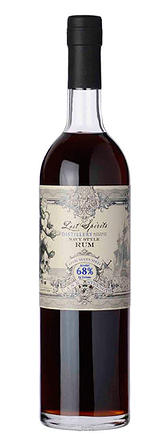FWIW...
Hass, I wish I could speak with more authority in re bourbon, but I can't. I do keep an email relationship with Chuck Cowdery (see above) so I'll try to see if I can ask the question. Check this quote his book "Straight Bourbon":
"Aged whisky (Bourbon) gets its reddish-brown color and much of its flavor from the new charred oak barrel. Although two years of aging is the legal minimum, four to six years is typical for a standard bourbon or rye... Younger whiskys (under four years) are required to label their age".
.
I'd venture to say that our distillers "fast aging" with slabs of wood is far less than four years, especially as he is scrupulous in avoiding any statement of age whatever (see link in previous post). Even the words "months" or "years" aren't used. Red flag time, don't you agree? In the meanwhile, readers may be interested in visiting the Lost Spirits site, which is relatively information free:
www.lostspirits.net/
Here's the bottle, this time showing the contents:

This is the "dark mahogany" described elsewhere, no question about that, it reminds me of the heavily colored Zaya or some of the "dark" or faux "Navy" rums. On the website as much as the distiller is willing to share are a few marketing bullets designed to sound sophisticated or unique:
- Grade A Molasses
Wild Bacteria Banana Dunder
Oloroso Sherry Seasoned Virgin American Oak (new)
Photocatalytically "Charred" New American Oak Slabs
The molasses is a good one, used also by the remarkable Phil Prichard. Monkeying around with an overripe banana into the ferment is one thing; calling it "dunder" is quite another; this is NOT dunder as we know it. The notion of sherry seasoned NEW oak is not at all the same as purchasing a very expensive barrel actually used to age sherry for many, many years. What is it instead? Perhaps a way of introducing actual (and unlabelled) sherry into the rum? It is not even clear how these barrels are charred, but the distiller wants us to buy that by also exposing them to a particular light somehow - in mere minutes - replaces the chemical processes that take years and years in expensive wood aging.
Groundbreaking claims like these require real transparency, not just a rehash of Distilling 101 tweaked to include some marketing bullets.
You may also find it interesting that there was another American distiller - Daniel of Texas - who also tried to replace wood aging by introducing slabs or staves of various woods (including oak) into the barrels. Home distillers have also tried this. The notion - unsuccessful - was that by increasing the area of exposure that somehow, some way the spirit contained would age "faster". This was and remains...
Hogwash. See previous post above re why.
To be fair, very heavy charring will introduce some color. This was used by Mount Gay's "Black Barrel" in an attempt to finish a young rum in heavily charred barrels - but just for a short time - to smooth it out. It didn't work. Keep in mind that heavy charring destroys wood to create a layer of filtering carbon. Toasting does not.
Flat Ass Bottom Line
Until this distiller puts up a proper website and/or is more forthcoming about how this extremely dark rum can be produced with "fast" aging - and actually stating its real age - it's fair to question a new rum by this new distiller using amazing new and untested methods to ferment, distill, season and "fast age" such a rum.
We need to peel his banana...








